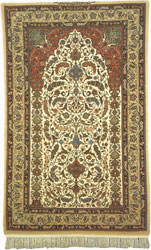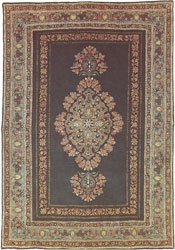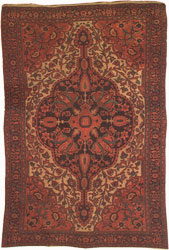
Tabriz | Heris | Zanjan | Bijar | Hamedan | Malayer | Kashan | Esfahan | Nain | Lilihan | Qom | Abadeh | Ghashghai | Mashhad | Ghouchan and Sarakhs | Turkoman rugs | Ferdous
Tabriz capital of Azarbaijan , has for centuries
enjoyed a great reputation as an important weaving centre in Iran. In this
city, carpet weaving
 has
had a long record . During the period of Mongol domination ( 1221 - 1449
) the city of Tabriz together with the city of Harat (in ancient Khorasan)
was one of the outstanding trade centres where the carpet industry was in
its utmost stage of evolution. For many long years Tabriz carpets with their
interesting designs, durability, fineness, and pleasant colours have always
been sought after in Iran and abroad. In the last seventy years the
prevailing designs consist of vases with flowers, trees, animals,
hunting, scenes, Mehrabi (Prayer rugs) with candelabra, branches and leaves
with scattered tiny flowers, repeated panels, overall panels, and panoramic
. The dimension of Tabriz productions vary from the smallest up to the biggest
sizes.
has
had a long record . During the period of Mongol domination ( 1221 - 1449
) the city of Tabriz together with the city of Harat (in ancient Khorasan)
was one of the outstanding trade centres where the carpet industry was in
its utmost stage of evolution. For many long years Tabriz carpets with their
interesting designs, durability, fineness, and pleasant colours have always
been sought after in Iran and abroad. In the last seventy years the
prevailing designs consist of vases with flowers, trees, animals,
hunting, scenes, Mehrabi (Prayer rugs) with candelabra, branches and leaves
with scattered tiny flowers, repeated panels, overall panels, and panoramic
. The dimension of Tabriz productions vary from the smallest up to the biggest
sizes.
Heris for a long time was well known in Iran and abroad for the long lasting woollen and silk carpets woven in pleasant and agreeable colours. Although the method of weaving these carpets is the same, yet they rarely resemble each other, they are produced in Heris and in thirty nearby villages in medium and big sizes as well as runners. The design of Heris carpets is normally stylised with a very big medallion in the centre that almost covers the field; the corners, too, resemble the centre medallion . The predominant colours are ivory, brownish red, dark and bright pink and blue.
In the province of Zanijan, three different Kinds of carpets are made. The first is double weft and thick - woven, the second kind of carpets are those woven in Afsharieh with double - weft and with very fine designs and colours . Although they resemble those made in Bijar yet they cost much less because the structure, unlike that of Bijar, is not well balanced. The last category is similar to Hamedan rugs. Carpets woven many years ago have had interesting colours such as light blue, light orange and black (a colour rarely used in Iran). Other colours that one can find in Zanjan productions are red, blue, brown and beige. The most common dimensiond are Sajjadeh and runners.
Carpet weaving in this area has been a traditional occupation for hundreds of years. Throughout their history the weavers of Bijar have used up to three and even five wefts in each row of knots.
This is much hravier carpet than the typical Sanandaj style. They should always be rolled instead of folded before being moved. There are various designs in Bijar carpets .
Some of the dominant designs are as follows:Botteh, Harati, Mina - Khani, Zell-e - sultan , Golfarang (flower bouquets). The size of Bijar carpets is approximately 1.5 up to 10 square metres. Runners are relatively rare.
All the carpets of this area have Ghiordes ( Turkish)knots and are thick piled. The dominant colours in this region are red, blue, indigo. ivory and pink.
The province of Hamedan is located in the west of Iran , The capital of this province , is one of the most ancient and historical cities of Iran.
Its origin goes back to the second millennium b.C. the Medes made in their capital. After the conquest of Alexander the Great the Greek ( 331 b.c) name Ekbatana was used.
This province is one of the most important regions in Iran that produces Iarge quantities of carpets but usually they are commercial quality . Sometimes one can find fine carpets in Hamedan . Few villages make carpets (Iarge size) but rugs predominate, with one or two areas specialising in runners.
In this province the carpets are woven in floral and stylish patterns.
In the city of Malayer carpet weaving is very popular and has a good market. The design , specially the older ones, which are very common in Malayer, are more or less similar to those made in Arak region such as Sarugh and Farahan .
Some carpets of this region are famous by the name of Armani - baft that has the same design as the Caucasian carpets The ancestor of these weavers had emigrated from Caucasia and Armenia in the 17th century, therefore all the carpets woven in Malayer and its surrounding villages are in stylish patterns, mostly in medallion and Harati design.
The sizes often demanded are runners , Kalleghi and Sajjadeh.
Esfahan, was one important centre for the
cultivation of various plants used in dyeing Ronas (Madder) as well
as wild plants containing coloured products can now be found in its mountains and deserts.
coloured products can now be found in its mountains and deserts.
At the time, due to their abundance, a lot of natural colours were used in the dyeing centres. At present, however, large quantities of dyestuffs. particularly chromatic compounds are used for dyeing the fibres of the carpets . The numbers of the dyestuffs in Esfahan carpets are mostly in beige, buff - white, red, dark blue and turquoise. The wool used for weaving is obtained from Kerman , Yazd , Khorasan Kermanshahan and foreign source . Esfahan carpets are the best of Persian products and are as hard wearing and they are very decorative.
The piles of good quality Esfahan carpets are thick and made of Kork the foundation are of cotton the finest ones are woven on silk.
In the small panel of the Iranian flag at bottom or top of the fine rugs of Esfahan, the weaver's signature is woven. There are some other towns and districts in the province of Esfahan where carpet weaving has had a wide circulation. They are as follows.
Not long ago most of the Kashan rugs were
woven with Merions wool, but because of its high cost, the usage of it was
limited. At
 present
the wool needed in Kashan and its dependencies is provided from internal
sources such as Khorasan, Kermanshahan and Tehran. Formerly"Kork" and fine
silk carpets were produced in Kashan but nowadays Qom is the leader in producing
carpets of this category.
present
the wool needed in Kashan and its dependencies is provided from internal
sources such as Khorasan, Kermanshahan and Tehran. Formerly"Kork" and fine
silk carpets were produced in Kashan but nowadays Qom is the leader in producing
carpets of this category.
Fast - coloured, double - weft and Senneh knotted rugs and carpets most often have lacquer - red , dark blue, turquoise blue, off - white beige brown and pistachio green background.
All formats, especially from about 1.5 x 2-20 m. up the large sizes common. Runners are relatively rare.
Shah - Abbasi medallion and corner, overall Shah - Abbasi , Overall vases candelabra medillion, tree with mehrab, portrait, panorama and geometrical Josheghan designs are those mostly woven in Kashan. Warp and wefts are of finely spun cotton.
Different kinds of carpets and rugs resembling those of Kashan are woven in the dependencies and the villages such as Nush - Abad , Aran , Fin , Natanz , Ghamsar and Ravand .
Near the border of the central desert and
along the road from Esfahan to yazd is the city of Na'in famous for its
fabulous and splendid rugs. Many years ago the Aba (sleeveless cloak), was
finely woven with camel's wool in Na'in. Almost eighty years ago, the government
of
 that
time prohibited the wearing of old - fashioned clothes. The weavers of the
Aba were forced to change their profession and they started a new enterprise.
The result was the creation of the beautiful and fine rugs that gained world
wide fame both in Iran and abroad.
that
time prohibited the wearing of old - fashioned clothes. The weavers of the
Aba were forced to change their profession and they started a new enterprise.
The result was the creation of the beautiful and fine rugs that gained world
wide fame both in Iran and abroad.
In the beginning, the designs were those of Bakhtiari and Yazd carpets , and especially those of Esfahan . After the Second world War specific and determined patterns were made which were gathered from the whole collection of carpet designs in Iran. One of the special features of Na'in carpets is the insistence of the dyers to use cool colours. Their Preference is white, dark blue, light blue, beige and sometimes red. The dimension of the Na'in rugs vary from the smallest sizes (Poshti) up to larger sizes. Warp and weft are made of cotton, the pile is made of wool they normally use the silk around the motifs to make the design outstanding . The designs often used in Na'in carpets are overall shah - Abbasi
Animal with multiple antlers multiple armlets (Bazu - bandi) shah - Abbasi medallion and corner. The weave varies between fine and extremely fine 3. 000 - 10 .000 Senneh knots Per.sq.dm. To determine the fineness of Na'in rugs the terms six ply (shesh - la) and nine ply ( noh - la) are often used. It's correct to explain that whenever one of the warps of a carpet is named noh - la . If two of the strings get separated, then the term shesh - la is used , shesh - la is much finer than noh - la.
Amongst the Armenian community of this district,
Lilihan carpets are the most famous. These carpets have a velvety surface
and are finely woven.
The design and to a certain extent the colours of Lilian carpets resemble those of "American Sarugh" Herewith, some explanation is given regarding the Armenian Sarugh rugs mentioned above .
At the end of the First World War, a representative of an American firm, K.S.Taushanjian of New York, who had commercial carpet activities in Arak, chose and created some patterns that he himself selected from the designs commonly used in Arak and Sarugh.
Corresponding to these designs a large quantity of two - weft carpets with long pile in different sizes, with a red field and dark - blue border, or light - beige field with dark - blue border, were woven separately from each other . The long piled and beautiful carpets woven in the villages of Vies, situated in southern Arak have geometrical Botteh and Harati designs.
Moreover the skilful artisans have created a geometrical design that is very particular and difficult to find in the nearby villages.
In the past and at present, Qom in one of the most important centres for producing silk, Kork and silk - touch (Gol - Abrisham) carpets.
The size are mostly Zar - o - nim, Do -
zar and the carpets of 4 , 6 , 7 and 12 sq. m. Warp and weft are mainly
of vary finely spun cotton. In silk rugs the weft are also silk.
The carpets are woven in the Persian knots with 2.500 up to 10.000 knots per sq. dm. Silk carpets even more than this . The colour of the carpets woven in Qom are as vast and various as its designs.
The dyers utilise natural or steady chemical colour, preferably pastel, turquoise, mustard, golden yellow, bright red, dark blue and beige.
Instead of drawing and designing their own patterns, the weavers prefer to change slightly the design of the carpets which has a great demand in other weaving centres of Iran. In this case, one can be mistake, identity a rug or a carpet of Qom as a carpet of Kashan or Esfahan but this error never occurs in Tabriz carpets as these are always woven with




